Apple MacBook Pro 13: Can a Mac Be a Decent Windows Laptop?
by Vivek Gowri on October 14, 2010 9:00 PM ESTApple MacBook Pro 13—Surprisingly Powerful 320M
Ah yes, the NVIDIA GeForce 320M, a.k.a. the excuse given for why the MBP13 is still running Core 2. It’s an integrated chip, with 256MB of system memory allocated to the IGP. As I said before, it’s got 48 CUDA cores clocked at 450 MHz, compared to the G 310M (in most of ASUS’ ultraportables) which has 16 CUDA cores at 625 MHz. It’s based on NVIDIA’s GT216 core and is basically an integrated version of the GeForce GT 325M. Interestingly, NVIDIA also has a similarly (and rather confusingly) named GT 320M (found in the HP dv6/7t) but that is a dedicated card with a stripped version of the GT216 core and has 24 pixel pipelines clocked at 500 MHz.
So, there’s your NVIDIA mobile GPU lesson for the day. But here’s the basics—the 320M is the replacement for the old 9400M and is basically a GT 325M integrated into the chipset. We expect it to run squarely in between the ASUS ultraportables and the N83Jv/Alienware M11x (GT 335M), slightly slower than the GT 325M, and somewhere around the ATI HD 5470. Here's how gaming performance stacks up.
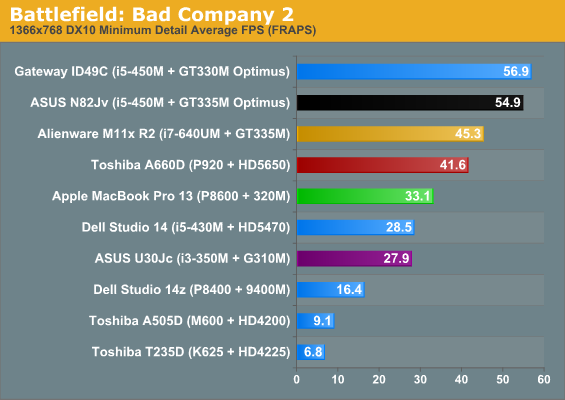
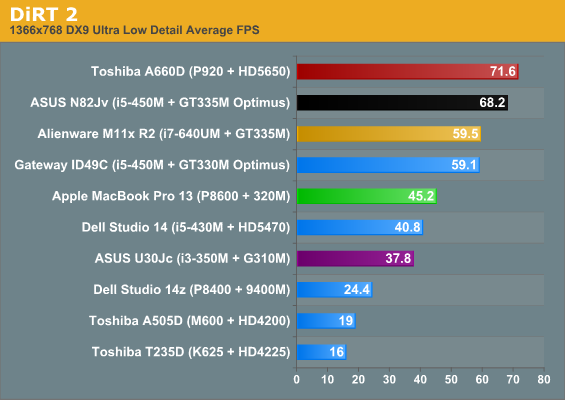
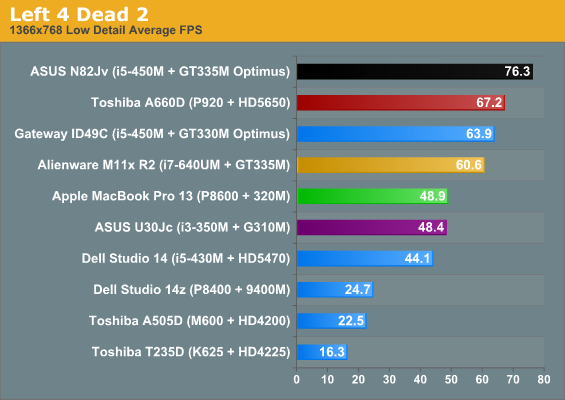
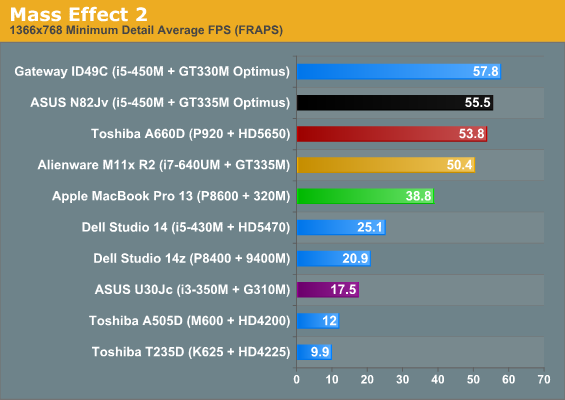
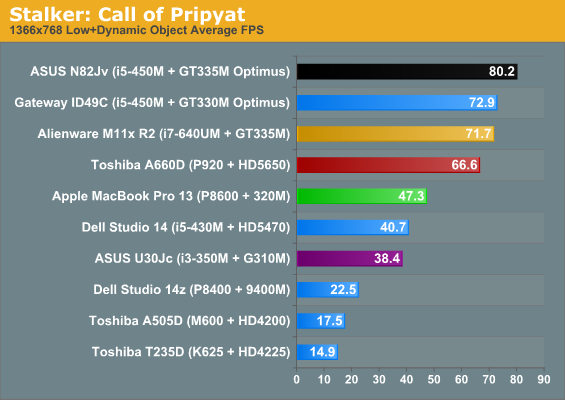
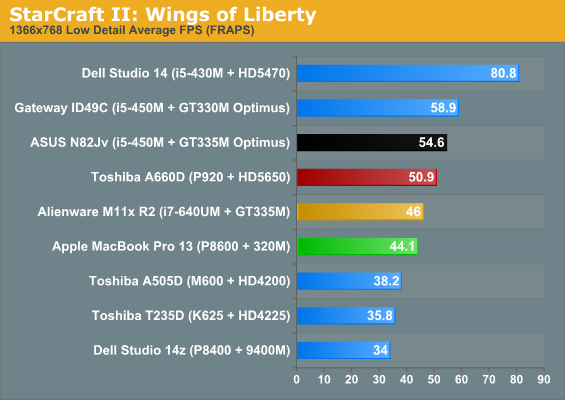
Under low settings, the MBP ended up around 10% faster overall than the Dell Studio 14, which has the HD 5470 (excluding the StarCraft II number). The Alienware M11x, ASUS N82Jv, and Gateway ID49C remain quite a bit faster, as expected, while the ASUS U-series end up significantly slower. The other integrated solutions (9400M, HD 4200/4225) are comparatively woeful. With the G 310M, you can play basically everything in our benchmark suite (except Mass Effect 2) at native res, lowest detail settings. With the other integrated graphics solutions, you need to take the resolution down a few notches to get anything even resembling a playable frame rate.
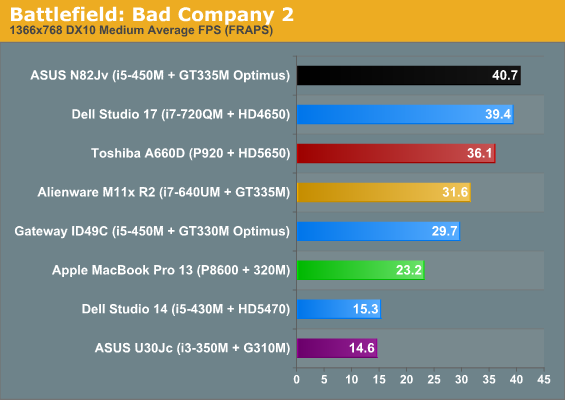

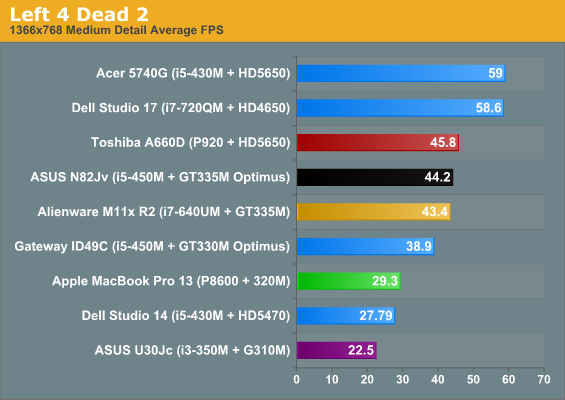
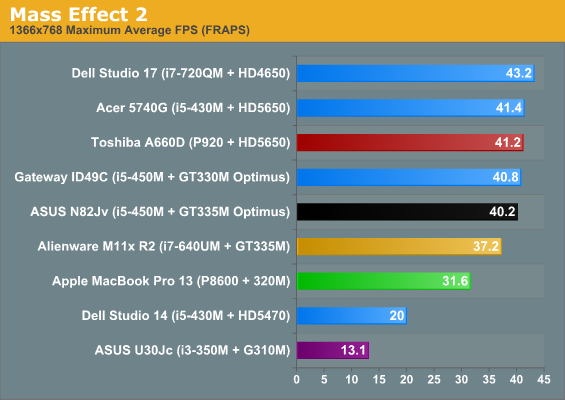
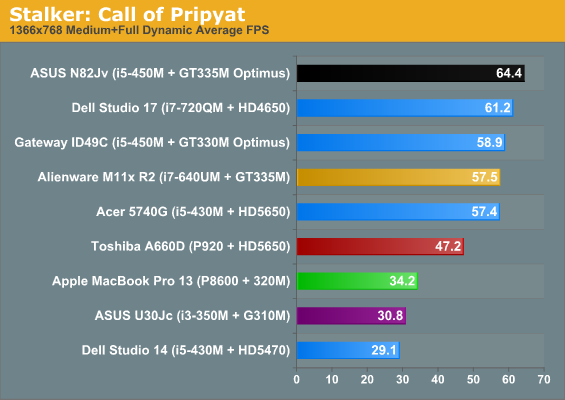
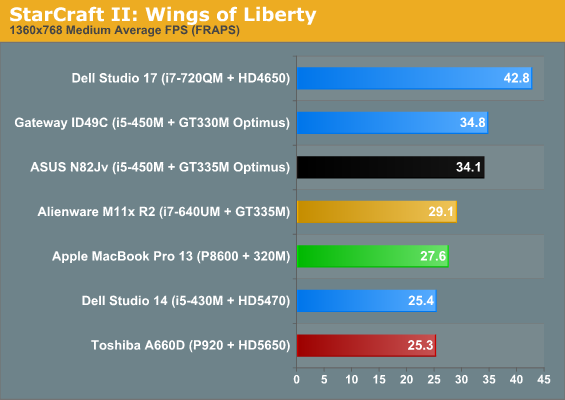
At medium detail settings, I expected the 320M to falter, but it surprised me by staying playable in all of our benchmarks. Bad Company 2 is a bit low, but if you really want to play it at Medium it’s possible, unlike with the G 310M and other low end dedicated graphics units. Frame rates in the mid-20 to low-30 range are awesome by mobile IGP standards. Things that aren’t playable on the G 310M, like Mass Effect 2 and Left 4 Dead 2, hit the magical 30 fps mark with the 320M. The 320M performs more like a midrange mobile GPU than any shape or form of integrated graphics; this is understandable given it’s roots as an integrated GT 325M, but it's still pretty awesome.










117 Comments
View All Comments
disappointed1 - Friday, October 15, 2010 - link
I don't think your comparison holds. Movies can only ever be compared with reviews & scores on a star-based system, whether from newspaper critics or laypeople on IMDB, unless perhaps you are suggesting that you read the script beforehand to identify a weak script or watch clips to identify weak acting. If not, then the star system is still inherently subjective, whether you're looking at one reviewer or the aggregate reviews of millions.When I say 3DMarks are meaningless, arbitrary numbers, I mean that I can't go out and play 3DMark at 8,710 3DMarks. I can, however, play FC2 at a standardized resolution at 60fps, and as you imply, I'd even prefer that be just one factor in the review. There are tons of other games that include built-in, standardized benchmarks that report in meaningful frames-per-second, and more of these games should be substituted for the meaningless 3DMark numbers.
Sufo - Monday, October 18, 2010 - link
I think the comparison holds insofar as it makes my point that even subjective information - when presented as part of a larger body of information - can still hold value. Apart from that the two have next to nothing in common :)Personally I don't think it can hurt to have 2 extra (I say extra, they're already there) bars in a review - they're certainly not so ostentatious that they might preclude one's ability to ignore them, and at the same time there may be people that want em. If a review was *entirely* based around benchmarks then i'd understand the resulting frustration.
Incidentally, my gpu tends to do better in 3dmark than cards it's better than, and worse than cards it's not. This may be a lucky coincidence, but for me at least it provides a quick, albeit *somewhat* dubious reference point, as most new hardware will def get a 3dmark run, whereas it may not have been run against games i've benched.
beginner99 - Friday, October 15, 2010 - link
Are there any test around with battery live in linux? Is the better battery live a general linux/unix advantage or did apple tweak OSx on their own so much?Anyway makes you cry as a windows user...
(I recently installed Jolicloud on my eeepc. As far as I know it runs as a Virtual machine next to windows (dual boot). But it is still much faster and more responsive. pretty weird especially the responsiveness.)
JarredWalton - Friday, October 15, 2010 - link
I looked at this a while back with a couple laptops:http://www.anandtech.com/show/2840
At the time, Win7 bested WinXP bested Vista, with Ubuntu generally far behind. It may have improved since then, but drivers and power optimizations are critical to get the most out of your hardware in terms of battery life, and Apple has obviously spent some time in OS X on this stuff. Win7 is good, but the wide compatibility isn't helping it keep up with OS X.
kawatwo - Friday, October 15, 2010 - link
I bought a 13 inch MBP just to get some Mac experience and it is a beautiful screen. It makes a great coffee table laptop with the perfectly lighted keyboard as well. I am curious how much the faster 2.66 CPU would have helped on the benches, but that does lower the value equation a bit probably too. It handles every game I own so far at 1200x800 though not all at highest quality settings of course. Just as an aside after several months using OS X it still boots to the desktop in about 40 seconds with zero fine tuning with the stock HD which I find amazing.yyrkoon - Friday, October 15, 2010 - link
Not enough to spend the extra ~$40 USD. Or, in your case ~$259 USD to replace the CPU with a newer one. The P8600 is actually a very good CPU.As an example. I have an E6550( 2.33Ghz stock ) C2D overclocked to 2.8Ghz, and barely notice a difference. Mainly, I just did it because I could, and to run the "FSB" 1:1 with my memory. Even overclocked on up to around 3.8Ghz, there is barely a noticeable difference. Unless you start benchmarking games, and comparing FPS. But playing the games, either stock, or overclocked. The difference is barely, if even conceivable.
seanleeforever - Tuesday, October 19, 2010 - link
i really think your booting speed has more to do with what you install, than the h/w spec or the OS.my netbook with 1.6G atom processor still boot up in 40 seconds after 2 years of use. so?
plewis00 - Friday, October 15, 2010 - link
Is the battery life thing anything to do with BIOS in regular PCs vs. EFI in Mac machines? In a previous article it had been mentioned that Windows 7 'could' run on Moorestown (Intel's new Atom) but due to the constant bus-polling, etc. that is built into Windows it could never achieve low-wattage idles and the bus-polling is part of the antiquated BIOS architecture PCs use - this is just a theory, but also having read UEFI-based PCs could boot in seconds, I imagine Mac OS X's speed and efficiency is down to having semi-custom hardware with many unnecessary and legacy processes not running. I could be wrong and if I am and someone knows please explain where.fokka - Friday, October 15, 2010 - link
i must say when i saw the article i was really looking forward to reading it, because it's exactly what i am doing right now - trying out win7 on the latest 13" mbp.but in the end it seemed a little too positive, at least to me.
while i agree, that the the 13 incher is a great little machine, especially on windows its not without it flaws.
the first thing that comes to my mind is the long booting time. i think it has to do with the bios-emulation, but that really shouldn't last that long.
second there is the choppy and much too fast scrolling, which i yet have to find out how to slow it down.
the third point is not a windows-one, but never the less i have to mention it: the display is not that good. sure, on paper and even in real life it looks fine with high contrast, brighness and color gamut, but it still is a tn-panel and so the viewing-angles are only "good enough".
there are other shortcomings as a win-notebook, too, like the keyboard-layout and, of course, battery life.
so all in all it's a great machine, but it sure as hell isn't designed for windows.
mrsmegz - Friday, October 15, 2010 - link
I had a Macbook 13 aluminum w/ the 9400 for a year. I really liked the notebook for all the reasons mentioned above, the touchpad, the screen keyboard etc. However I had more than a few hangups running Windows 7 on the laptop. 1), Bootcamp wouldn't support 64 bit windows 2) Sound would only come out of one speaker/headphone at about 20pct volume while the other was at 100pct 3) it got so damn hot sitting in your lap, the aluminum just didn't vent the laptop enough. Everything else on Windows though, worked much as the article explained, If they fix those problems, I will consider getting another next cycle.